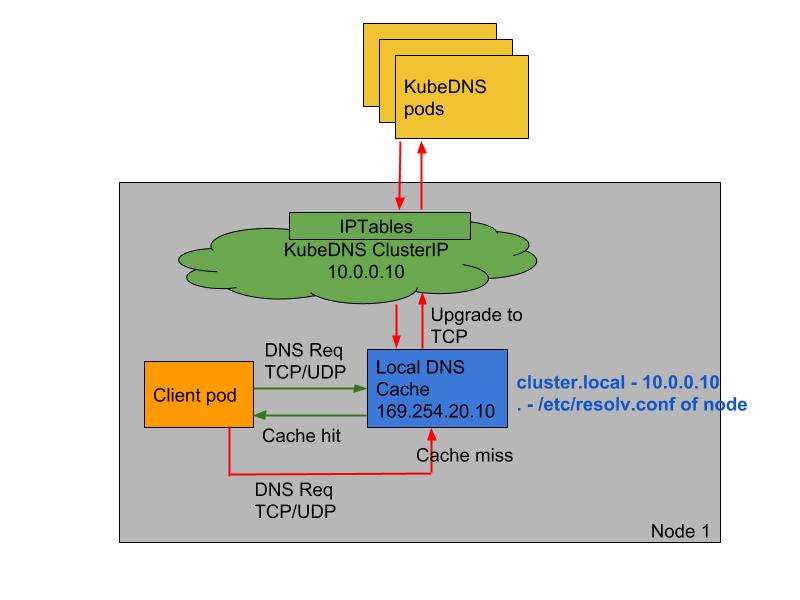Using NodeLocal DNSCache in Kubernetes clusters
Kubernetes v1.15
beta
- The version names contain beta (e.g. v2beta3).
- Code is well tested. Enabling the feature is considered safe. Enabled by default.
- Support for the overall feature will not be dropped, though details may change.
- The schema and/or semantics of objects may change in incompatible ways in a subsequent beta or stable release. When this happens, we will provide instructions for migrating to the next version. This may require deleting, editing, and re-creating API objects. The editing process may require some thought. This may require downtime for applications that rely on the feature.
- Recommended for only non-business-critical uses because of potential for incompatible changes in subsequent releases. If you have multiple clusters that can be upgraded independently, you may be able to relax this restriction.
- Please do try our beta features and give feedback on them! After they exit beta, it may not be practical for us to make more changes.
This page provides an overview of NodeLocal DNSCache feature in Kubernetes.
Before you begin
You need to have a Kubernetes cluster, and the kubectl command-line tool must be configured to communicate with your cluster. If you do not already have a cluster, you can create one by using Minikube, or you can use one of these Kubernetes playgrounds:
To check the version, enter kubectl version.
Introduction
NodeLocal DNSCache improves Cluster DNS performance by running a dns caching agent on cluster nodes as a DaemonSet. In today’s architecture, Pods in ClusterFirst DNS mode reach out to a kube-dns serviceIP for DNS queries. This is translated to a kube-dns/CoreDNS endpoint via iptables rules added by kube-proxy. With this new architecture, Pods will reach out to the dns caching agent running on the same node, thereby avoiding iptables DNAT rules and connection tracking. The local caching agent will query kube-dns service for cache misses of cluster hostnames(cluster.local suffix by default).
Motivation
With the current DNS architecture, it is possible that Pods with the highest DNS QPS have to reach out to a different node, if there is no local kube-dns/CoreDNS instance.
Having a local cache will help improve the latency in such scenarios.Skipping iptables DNAT and connection tracking will help reduce conntrack races and avoid UDP DNS entries filling up conntrack table.
Connections from local caching agent to kube-dns servie can be upgraded to TCP. TCP conntrack entries will be removed on connection close in contrast with UDP entries that have to timeout (default
nf_conntrack_udp_timeoutis 30 seconds)Upgrading DNS queries from UDP to TCP would reduce tail latency attributed to dropped UDP packets and DNS timeouts usually up to 30s (3 retries + 10s timeout). Since the nodelocal cache listens for UDP DNS queries, applications don’t need to be changed.
Metrics & visibility into dns requests at a node level.
Negative caching can be re-enabled, thereby reducing number of queries to kube-dns service.
Architecture Diagram
This is the path followed by DNS Queries after NodeLocal DNSCache is enabled:

Nodelocal DNSCache flow
This image shows how NodeLocal DNSCache handles DNS queries.
Configuration
This feature can be enabled using the command:
KUBE_ENABLE_NODELOCAL_DNS=true kubetest --up
This works for e2e clusters created on GCE. On all other environments, the following steps will setup NodeLocal DNSCache:
- A yaml similar to this can be applied using
kubectl create -fcommand. - No need to modify the –cluster-dns flag since NodeLocal DNSCache listens on both the kube-dns service IP as well as a link-local IP (169.254.20.10 by default)
Once enabled, node-local-dns Pods will run in the kube-system namespace on each of the cluster nodes. This Pod runs CoreDNS in cache mode, so all CoreDNS metrics exposed by the different plugins will be available on a per-node basis.
The feature can be disabled by removing the daemonset, using kubectl delete -f command. On e2e clusters created on GCE, the daemonset can be removed by deleting the node-local-dns yaml from /etc/kubernetes/addons/0-dns/nodelocaldns.yaml
Feedback
Was this page helpful?
Thanks for the feedback. If you have a specific, answerable question about how to use Kubernetes, ask it on Stack Overflow. Open an issue in the GitHub repo if you want to report a problem or suggest an improvement.